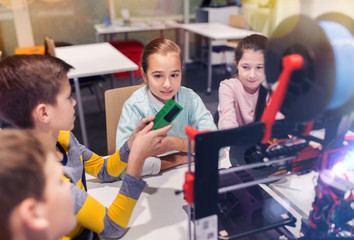In an era defined by rapid technological advancements, one innovation stands out for its potential to revolutionize learning: 3D printing. This groundbreaking technology is no longer confined to industrial design and manufacturing; it’s moving into our classrooms, transforming the way we teach and learn. The concept of a Digital Makerspace, a collaborative workspace inside a school where students can explore and learn about 3D printing, has introduced a new dimension in education.
Understanding 3D Printing
3D printing, or additive manufacturing, is a process that creates three-dimensional solid objects from a digital file. It works by laying down successive layers of material until the object is fully formed. The technology behind 3D printing is diverse, with techniques such as Stereolithography (SLA), Fused Deposition Modeling (FDM), and Selective Laser Sintering (SLS) being used. The materials employed range from plastics to metals and even ceramics, offering a wide array of possibilities for creation.
Role of 3D Printing in Education
The transformative power of 3D printing is felt most strongly in education. By offering hands-on learning opportunities, it fosters creativity, critical thinking, and problem-solving skills. Students who visualize and manipulate 3D objects gain a better understanding of complex concepts, making abstract ideas tangible and easier to comprehend.
Digital Makerspaces in Schools
A Digital Makerspace is a dedicated area within a school that provides access to 3D printers and related software. These spaces are more than just rooms filled with high-tech equipment; they are hubs of creativity and innovation where students design, experiment, and build their own creations. The benefits are manifold, promoting teamwork, enhancing problem-solving skills, and bridging the gap between theoretical knowledge and practical application.
Implementing 3D Printing Services in Classroom Assignments
The application of 3D printing in classroom assignments is a progressive step towards modern education. Students can design and print models to demonstrate scientific principles or create replicas of historical artifacts for history lessons. Integrating 3D printing into assignments requires careful planning, guiding students in designing their 3D models, and facilitating the printing process, but the result is a richer, more engaging learning experience.
Case Studies
Several schools have successfully integrated 3D printing into their curriculum. For instance, New York’s Marymount School has a dedicated Makerspace where students use 3D printers for various projects, enhancing their learning experience. These case studies demonstrate that with the right resources and approach, 3D printing can be a powerful educational tool.
Challenges and Solutions
Despite its benefits, integrating 3D printing into classrooms is not without challenges. High equipment costs, lack of technical knowledge among staff, and the need for curriculum adjustment are common obstacles. However, solutions exist: grants or partnerships can help offset costs, professional development programs can enhance teacher competence in using the technology, and gradual implementation can ease the transition into a new curriculum.
Future of 3D Printing in Education
As 3D printing technology continues to evolve, its role in education is set to expand. We can expect more intricate designs, wider material options, and even integration with other emerging technologies like virtual reality. The future of Digital Makerspaces in schools is promising, poised to redefine traditional teaching and learning methods.
Conclusion
3D printing holds immense potential for enriching classroom learning. By embracing this technology, schools can provide students with an interactive, engaging, and practical learning experience. It’s time for educators to consider integrating 3D printing into their teaching methodologies, preparing students for a future where digital manufacturing could become the norm.
In conclusion, the journey towards integrating 3D printing in classrooms may be challenging, but the educational rewards it promises are well worth the effort.



